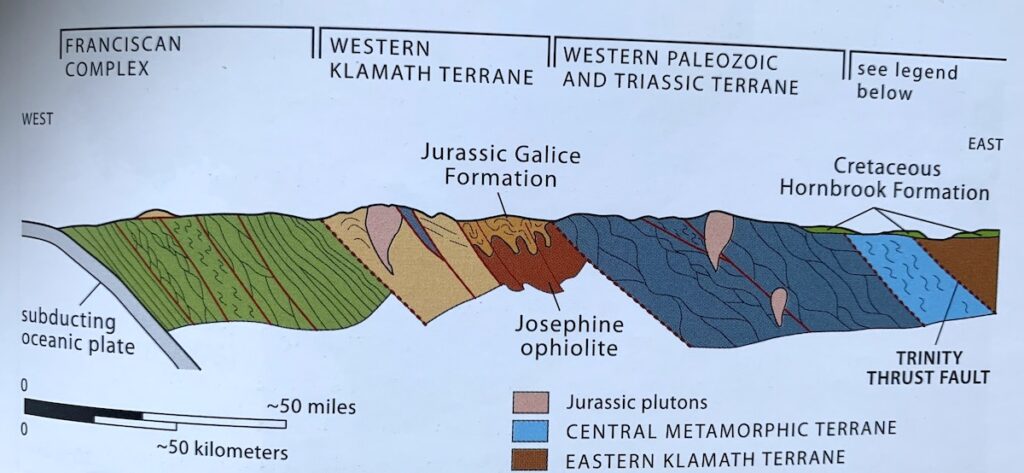Marble Mountain Wilderness in northern California
Marble, with its typical brilliant white color, is beautiful! And it’s rare on the U.S. west coast. So I was excited to finally visit the Marble Mountains in northern California via a backpacking trip from July 13–16. Five of us traveled 2 hours south from Ashland, Oregon, and parked at the Lovers Camp trailhead. From there, we hiked up to Marble Valley and set up our camp. We then had several days to hike around with only our day packs.

What is marble?
Marble is a metamorphic rock that forms when limestone (a sedimentary rock) is buried deep beneath Earth’s surface where elevated temperatures and pressures cause carbonate minerals (calcite, aragonite, dolomite) to recrystallize. Limestone is a biological type of sedimentary rock—it consists of organisms’ hard parts that range from tiny single-celled algae and animal plankton to mollusks such as clams to large coral reefs. Most limestone forms in the ocean, so when we find this rock on land it means the land was once covered by ocean water or that pieces of oceanic crust with overlying limestone rock was accreted (added) to the continent.
Limestone is abundant in the mid-west and eastern parts of the U.S. Most of those rocks were deposited during times in the Paleozoic and Mesozoic Eras when the continent was flooded by the ocean. Limestone is less common along the U.S. west coast—at most of these locations oceanic crust was added to the continent during hundreds of millions of years of plate tectonic activity related to the subduction of oceanic plates and their accretion onto continental plates.
The Klamath super-terrane
The Marble Mountains are part of the very complicated area between Reading, California and Roseburg, Oregon called the Klamath terrane. A terrane is a crustal block that is bounded by faults and displaced from where it originally formed. The Klamaths are a “super-terrane” because they are an amalgamation of many separate terranes.

The Marble Mountain Wilderness is in the Rattlesnake Creek terrane (white cobbled pattern) that is part of the Western Klamath belt of high-grade metamorphic rocks. The north end of the wilderness is located about 50 km (30 miles) west, and a little south, of Yreka. Map is from Stokes and Barnes, 2006 (see reference below).
The Klamath group of terranes has a long and complicated history. In a blog post about my local region around Ashland, Oregon, I provided a brief introduction to these mountains: https://landscapes-revealed.net/the-rogue-valley-region-in-sw-oregon-displaying-300-million-years-of-geologic-time/. Basically, the Klamaths consist of a vast variety of oceanic materials, including all parts of the oceanic crust and overlying marine sediments. These oceanic pieces were accreted to each other and then to the continent via a long history of subduction that included colliding volcanic islands.
Making the Marble Mountains
The terranes of the Klamath Mountains are separated by thrust faults (black lines with small triangles on map above), as shown on the cross section below.

Before it was metamorphosed, marble was limestone. Shells of organisms on the seafloor created limestone rock overlying oceanic crust formed by volcanic (magma erupted on the seafloor) and plutonic (magma cooled beneath the seafloor) processes. Because of the high metamorphic grade, very few fossils are preserved. The limestone probably formed in a reef around a volcanic island that was located closer to the equator and that traveled eastward and northward with an oceanic tectonic plate. When the plate encountered a subduction zone, pieces of the plate and the overlying sedimentary rock were accreted to the continent through a complicated series of collisions.
Components of the Marble Mountains







Caves and flowers
You may be aware that most caves are formed in limestone (or marble). This is because of chemical weathering: carbon dioxide in the air dissolves in rainwater to form weak “carbonic acid” that dissolves limestone as it seeps into cracks and cavities. Sure enough, there are abundant caves in the Marble Mountains. One of my former colleagues at San Francisco State University studied these caves (Davis and Serefidden, 2004, see reference below), and I have been wanting to visit these mountains since he told me about them many years ago.







We encountered employees of the California Native Plant Society (https://www.cnps.org/) who were mapping plants throughout the Klamath Mountains. Their data will eventually be available to the general public. Dana York is a retired naturalist who was volunteering with the native plant group. He has just co-authored a book about plants along the southern PCT (upper left photo). He is now working on a companion volume about plants on the northern PCT—stay tuned!
Coda

For photos of other beautiful marble rocks, visit my post about the famous Carrera marble quarry in northwestern Italy (https://landscapes-revealed.net/the-famous-marble-from-carrara-italy/). This marble block is much larger than California’s Marble Mountains and more accessible for quarrying.
Other beautiful carbonate rock are found in Italy’s Dolomite Mountains. To view photos of the Dolomites, see my posts in September 2022 (e.g., https://landscapes-revealed.net/trekking-through-an-ancient-sea-in-the-italian-dolomites/). These rocks were altered by fluids with magnesium that changed the original calcite (CaCO3) into dolomite [CaMg(CO3)2].
References
Davis and Serefiddin, 2004, The Marble Mountains of northern California: Alpine Karst journal.
Stokes and Barnes, 2006, The development of plate tectonic concepts for the Klamath Mountains province, California and Oregon: GSA Special Paper 410.
Alt and Hyndman, 2016, Roadside Geology of Northern and Central California: Mountain Press.


Studying wine regions throughout the world is helpful… I understand a fair amount of your share. And now I know more about marble ;-). Side note- many buildings and houses in Pau have marble floors from the nearby quarries. (The house we were supposed to buy had one.)
Nice! Today we visited Abacela winery, which has an interesting geologic setting on a major fault. Sounds like I’ll need to visit the marble quarries near Pau when we visit you sometime. Hope you find another house with marble floors!
Nice to learn the origin of the Marbles after hiking there so many times.
Thanks for reading Maria!
Excellent. Thanks!
Thanks for reading Keeley!
I have spent a good portion of my career learning from geologists and the education you provide in “landscapes-revealed” never disappoints. Your Marbles report brought to mind a geology question that I have regarding an area about 30 miles East of that range. Is there any way I can ask you my question and perhaps send some pictures?
I’ll send you an email!